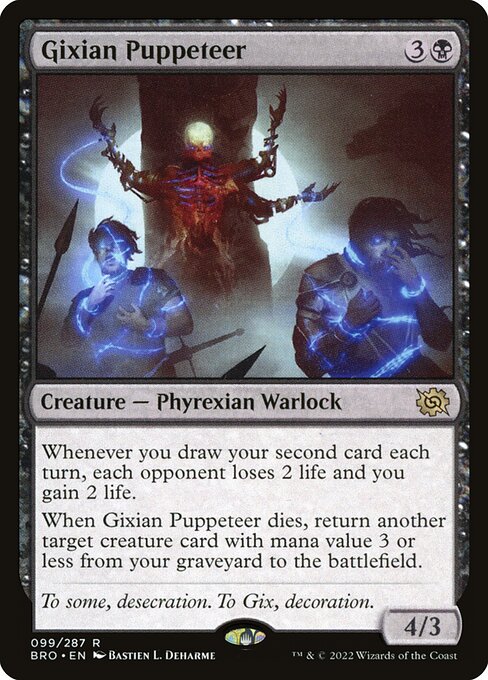
Image courtesy of Scryfall.com
Gixian Puppeteer and the Rarity-Usability Paradox
In Magic: The Gathering, rarity is a storyteller as much as a mechanic. Some rares become timeless staples in beloved archetypes, while others drift into the gray area between “collectible” and “playable.” The intricacies of The Brothers’ War give us a prime case study: a rare black creature that carries a surprisingly practical toolkit, yet remains something of a sleeper in the wider metagame. 🧙♂️🔥💎
Card snapshot: what the numbers and text actually do
- Name: Gixian Puppeteer
- Mana cost: {3}{B} (CMC 4)
- Type/Color: Creature — Phyrexian Warlock; color identity B
- Power/Toughness: 4 / 3
- Rarity: Rare
- Set: The Brothers’ War (BRO), released 2022-11-18
- Oracle text: Whenever you draw your second card each turn, each opponent loses 2 life and you gain 2 life. When this creature dies, return another target creature card with mana value 3 or less from your graveyard to the battlefield.
- Flavor: “To some, desecration. To Gix, decoration.”
- Flavor text flavor aside: This line captures the warped elegance of Phyrexian design—beauty through grafted menace.
- Price snapshot: USD 0.84; EUR 0.99 (non-foil), with foil at slightly higher margins
- Rarity-based nuance: The card’s strength isn’t in raw stats alone but in the tempo and recursion it enables—two threads that weave a surprisingly sturdy fabric for decks built around card draw and graveyard resilience
At first glance, the mana cost and body look respectable but not earth-shaking. The real sting comes from the trigger: every time you draw your second card in a turn, you nudge life totals around the table in your favor—each opponent drops two, you add two to your life total. In multiplayer formats, that’s a team-sized nudge toward the late game, while in duels it’s a clean exchange of resources. The death-trigger then acts as a second life for your graveyard plan, rebooting a 3-mana-or-less creature for another swing later on. It’s a rare that quietly rewards players who lean into card draw engines and resilient, cheap threats. ⚔️
Why rarity doesn’t always equal usability
The Brothers’ War era is replete with powerful flavor and glossy foil options, but not every rarity translates into consistent in-game impact. Gixian Puppeteer exemplifies a phenomenon many collectors know well: a card can be very good in the right shell, yet feel niche in the broader metagame. Rare status can drive initial appeal and price, but usability is dictated by how well a card synergizes with deck archetypes and how often that synergy actually resolves on the battlefield. This Puppeteer shines in builds that lean into card draw as a core mechanic and leverage graveyard recursion to outlast opponents. 🧙♂️🎲
“Rarity is a story you tell your friends at the table; usability is the punchline that lands when it matters.”
Format fallout: where Gixian Puppeteer earns its keep
Commander is where this card truly earns its keep. A 4/3 black beater that can drain life on every second draw, while offering a payoff when it dies, sits nicely in slower, value-rich aristocrat or graveyard-centric strategies. It’s not the cheapest or the flashiest option, but it rewards a patient game plan: draw engines, tutors, and ways to fuel your graveyard so that the final reanimation line feels earned. In 1v1 formats, the card remains a spicy, budget-friendly pick for black midrange, but its strength scales with groups and the number of times you can reliably draw more than one card per turn. In Pioneer and Modern, its impact is more situational, but the graveyard recast—returning a 3-mana-or-less creature—keeps options open for value plays, especially with synergy cards that care about death triggers or cheap survivable threats. 🔥
From a collector’s lens, this rare brings a respectful curiosity rather than a flood of demand. The price point reflects that balance—affordable enough for casual buy-and-play, while still offering a foil option for those who chase premium printings. The EDHREC rank sits in a respectable range (graphically meaningful to those who track archetype popularity), signaling that while not a marquee staple, it has carved out a thoughtful niche in the Commander community. ⚙️
Deck-building takeaways: turning rarity into practical usability
- Anchor your strategy around card draw engines that reliably push you to that “second card” each turn. The more consistently you trigger the life swing, the more you gain in tempo and attrition in multiplayer matches 🧙♂️.
- Pair with cheap, graveyard-friendly creatures you don’t mind reusing; the death-trigger offers value you can rely on, even against disruption.
- Consider protective and recursion-friendly black staples—discard outlets, graveyard hate control, and tutors—to maximize Puppeteer’s long game.
- Keep an eye on price-to-performance; even rare cards that reward play in the right shell can become budget-friendly powerhouses when the meta shifts. The current USD price is approachable for many, inviting experimentation without breaking the bank 🔥.
As a card from The Brothers’ War, Gixian Puppeteer also invites us to reflect on the era’s lore and design ethos. It’s a rare that wears its mechanics on its sleeve—draw shenanigans, life exchange, and a respectable reanimation clause—that can anchor a fun, resilient Commander deck or serve as a surprising value engine in casual modern play. The card’s story—desecration made decorative—fits the broader Phyrexian aesthetic: beauty that hinges on a dangerous edge. 🎨
For players who want to protect their prized prints and keep their decks looking pristine on the go, a premium phone case can be a quiet but meaningful companion. If you’re chasing a sleek way to carry your collection and keep it safe during travel to Friday night games, consider this option: